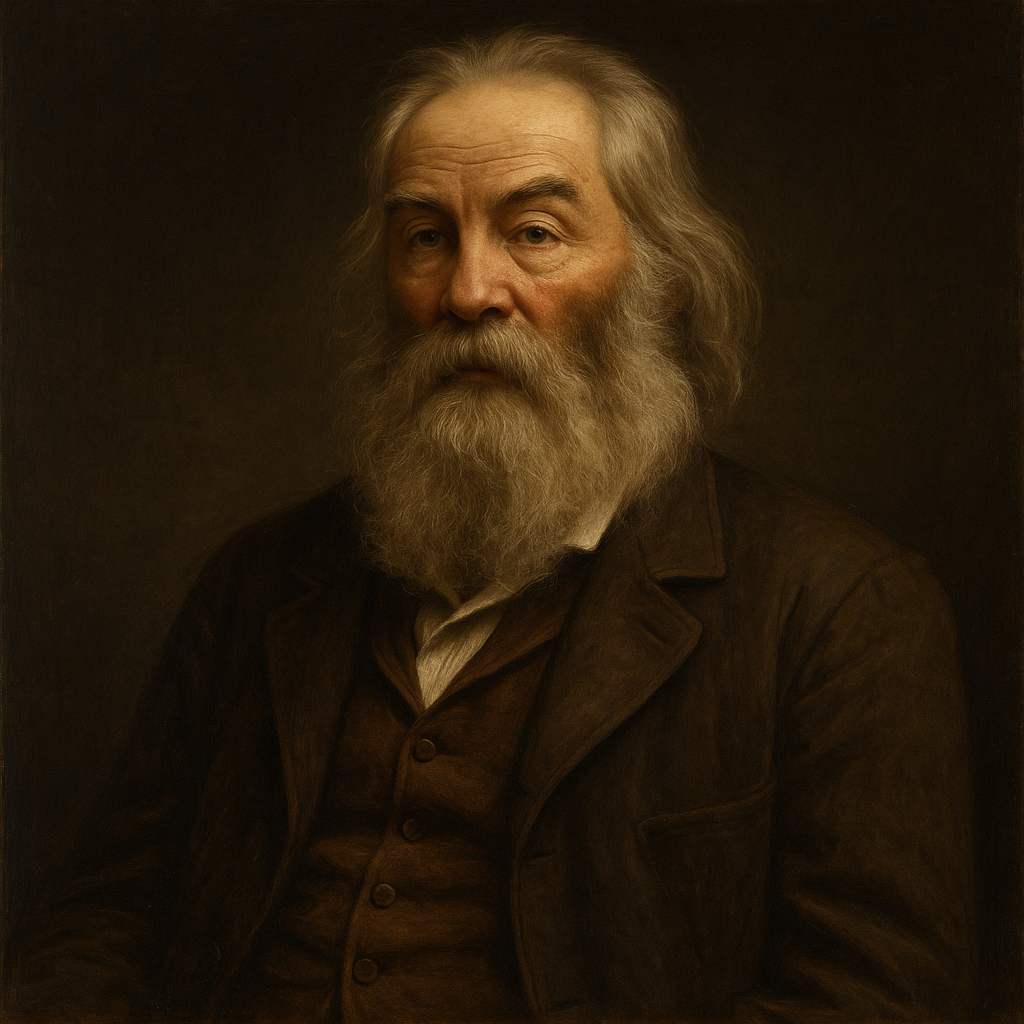A Noiseless Patient Spider
Walt Whitman
1819 to 1892

A noiseless patient spider,
I mark’d where on a little promontory it stood isolated,
Mark’d how to explore the vacant vast surrounding,
It launch’d forth filament, filament, filament, out of itself,
Ever unreeling them, ever tirelessly speeding them.
And you O my soul where you stand,
Surrounded, detached, in measureless oceans of space,
Ceaselessly musing, venturing, throwing, seeking the spheres to connect them,
Till the bridge you will need be form’d, till the ductile anchor hold,
Till the gossamer thread you fling catch somewhere, O my soul.
Walt Whitman's A Noiseless Patient Spider
Introduction
Walt Whitman's "A Noiseless Patient Spider," first published in 1868 and later included in his seminal work "Leaves of Grass," stands as a testament to the poet's masterful ability to weave profound metaphysical concepts into seemingly simple observations of nature. This concise yet profoundly rich poem encapsulates Whitman's transcendentalist philosophy, his deep connection to the natural world, and his constant grappling with the human condition. Through a meticulous examination of its structure, imagery, and thematic elements, this essay will explore how Whitman employs the spider as a powerful metaphor for the human soul's quest for meaning and connection in a vast, often indifferent universe.
Structure and Form
The poem is structured in two five-line stanzas, each presenting a distinct yet interconnected tableau. This binary structure is crucial to understanding the poem's underlying comparative framework. The first stanza focuses on the titular spider, while the second shifts dramatically to address the human soul. This parallel construction invites the reader to draw connections between the spider's physical actions and the soul's metaphysical journey.
Whitman's use of free verse, a form he pioneered and popularized, allows for a fluid, almost conversational tone that belies the poem's deep philosophical underpinnings. The lack of a rigid rhyme scheme or meter mirrors the spider's freedom of movement and the soul's unrestricted exploration. However, there is a subtle rhythmic quality to the lines, particularly in the repetition of "filament, filament, filament" in the fourth line of the first stanza, which echoes the spider's methodical work and the soul's persistent efforts.
Imagery and Symbolism
The poem's opening line, "A noiseless patient spider," immediately sets a tone of quiet determination and focused purpose. The adjectives "noiseless" and "patient" anthropomorphize the spider, imbuing it with qualities that Whitman clearly admires and sees as necessary for the soul's journey. The spider's isolation "on a little promontory" serves as a powerful visual metaphor for the human condition – we are, in essence, alone in our individual consciousness, surrounded by a vast, often incomprehensible universe.
The imagery of the spider launching "filament, filament, filament, out of itself" is particularly striking. This act of creation from within oneself resonates with Whitman's transcendentalist beliefs, suggesting that the tools for understanding and connecting with the universe lie within us. The repetition of "filament" emphasizes the persistent, incremental nature of this process.
In the second stanza, the imagery shifts to the cosmic scale. The soul stands "Surrounded, detached, in measureless oceans of space," a description that both parallels and amplifies the spider's situation. This vast, empty space serves as a metaphor for the philosophical and existential questions that humanity grapples with. The soul's actions – "musing, venturing, throwing, seeking" – mirror the spider's, but on a grander, more abstract scale.
Thematic Analysis
At its core, "A Noiseless Patient Spider" is an exploration of the human need for connection and meaning in a vast, often indifferent universe. The spider's web-spinning becomes a metaphor for the soul's attempts to create connections and find purpose. This theme resonates deeply with Whitman's transcendentalist philosophy, which posits that individuals can transcend the physical and empirical world to reach a higher spiritual or metaphysical plane.
The poem also grapples with the tension between isolation and connection. Both the spider and the soul are described as solitary entities, yet their entire purpose is to forge connections. This paradox reflects the human experience – we are fundamentally alone in our consciousness, yet we constantly seek to bridge that gap and connect with others and the world around us.
Persistence and patience emerge as key virtues in this quest for connection. The spider is described as "ever unreeling" its threads, "ever tirelessly speeding them." Similarly, the soul is depicted as "Ceaselessly musing, venturing, throwing, seeking." This emphasis on continuous effort suggests that the search for meaning and connection is not a single event but a lifelong process.
The poem also touches on themes of creativity and self-reliance. The spider produces its web from within itself, just as the soul must generate its own attempts at understanding and connection. This aligns with Whitman's belief in the power of the individual and the importance of self-discovery.
Literary Devices and Techniques
Whitman employs several literary devices to enhance the poem's impact. The use of apostrophe in the second stanza – "And you O my soul" – creates a sense of intimacy and self-reflection, as if the speaker is addressing a part of himself. This technique also serves to universalize the experience, inviting readers to consider their own souls' journeys.
Personification is used throughout the poem, most notably in the description of the soul's actions. By attributing human qualities to abstract concepts, Whitman makes the philosophical exploration more tangible and relatable.
The poem's final lines employ a series of parallel phrases beginning with "Till," creating a sense of anticipation and emphasizing the goal-oriented nature of both the spider's and the soul's efforts. The use of "gossamer thread" in the final line brings the metaphor full circle, explicitly linking the soul's quest back to the spider's web-spinning.
Historical and Literary Context
"A Noiseless Patient Spider" was written during a period of significant personal and national turmoil. Whitman had recently experienced the horrors of the American Civil War, serving as a nurse in army hospitals. This exposure to suffering and death likely influenced his contemplation of life's big questions, as reflected in this poem.
The poem also sits within the broader context of Whitman's lifework, "Leaves of Grass," which he continually revised and expanded throughout his life. This particular poem embodies many of the themes that run through "Leaves of Grass" – the celebration of the individual, the connection between the personal and the cosmic, and the search for meaning in the natural world.
In the larger literary landscape, this poem can be seen as a bridge between Transcendentalism and Modernism. While it embraces the Transcendentalist focus on individual experience and the spiritual dimensions of nature, its exploration of isolation and the struggle for meaning anticipates the concerns of Modernist literature.
Conclusion
Walt Whitman's "A Noiseless Patient Spider" stands as a masterpiece of concision and depth. In just ten lines, Whitman creates a rich tapestry of imagery and ideas, using the simple act of a spider spinning its web as a launching point for a profound exploration of the human condition. The poem's enduring appeal lies in its ability to address universal themes – isolation, connection, persistence, and the search for meaning – in a way that is both accessible and deeply moving.
Through his careful construction, vivid imagery, and thoughtful use of literary devices, Whitman invites readers to see themselves in the spider, to recognize their own souls' ceaseless efforts to make sense of the world around them. In doing so, he offers a message of both comfort and challenge – while we may be isolated in a vast and often incomprehensible universe, we have within us the capacity to reach out, to create connections, and to find meaning. The journey may be endless, but in Whitman's view, it is this very act of seeking that defines our humanity and gives purpose to our existence.
This text was generated by AI and is for reference only. Learn more
Want to join the discussion? Reopen or create a unique username to comment. No personal details required!



Comments
No comments yet. Be the first to comment!